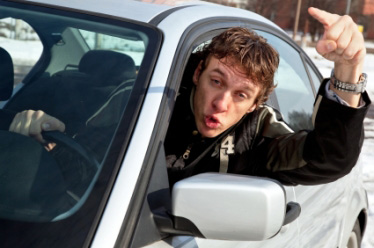How to avoid aggressive driving
Neil Bartlett
Driving aggressively is something nearly every driver does at some time. If you’ve ever run a red or yellow light, changed lanes without signaling to other drivers, tailgated or drove faster than the speed limit, you’ve driven aggressively.
You can’t control some factors that affect your driving, such as your age. But aggressive driving is something you can change – and it’s in your best interest. Getting a ticket can raise your insurance rates. And states and municipalities are getting tougher on offenders as they seek to reduce the number of traffic crashes and deaths.
 What does it mean to drive aggressively? It means using a vehicle in a way that endangers people or property.
What does it mean to drive aggressively? It means using a vehicle in a way that endangers people or property.
Common-sense solutions
“Aggressive drivers probably underestimate the number of other aggressive drivers on the road,” says Mike Barry, a spokesman for the nonprofit Insurance Information Institute. “By driving aggressively, you’re inviting a potentially contentious confrontation with another driver.” For instance, you could find yourself in a shouting match with another driver – a shouting match that could wind up with punches being thrown.
Here are five ways you put the brakes on aggressive driving.
- Be open to correcting unsafe driving habits that provoke other drivers – like changing lanes haphazardly, tailgating or gesturing rudely to other drivers. “Nine out of 10 drivers think their driving is above average,” says Russ Rader, a spokesman for the nonprofit Insurance Institute for Highway Safety. “It’s always the other guy who is the bad driver and should get off the road.”
2. Resist the urge to retaliate against another driver or “teach him a lesson.”
- Allow plenty of time to reach your destination so you’re not tempted to rush.
- If you can, avoid driving when traffic is most congested.
- If another motorist tries to engage you in a fight, don’t respond and don’t even make eye contact.
Aggressive driving and deaths on the road
A study conducted in 2009 by the AAA Foundation for Traffic Safety estimated that 56 percent of all deadly car crashes in a four-year period (2003-2007) involved aggressive driving. In the
The aggressive driving lineup is led by speeding, which accounted for 31 percent of deadly crashes in 2007. Failure to yield right of way came in second (11 percent).
Speeding is the most common act of aggressive driving. According to a 2012 report from the Governors Highway Safety Association, the number of deaths involving speeding has stayed the same for 25 years.
Rader says aggressive driving ranks as one of the biggest problems on
“While we’ve made progress in reducing drunk driving and getting people to buckle up, speeding and other types of aggressive driving is an area in which too many lives continue to be lost,” says Jonathan Adkins, a spokesman for the Governors Highway Safety Association.
According to the governors’ group, speed enforcement programs and public awareness campaigns are effective tool in helping curb aggressive driving.
Who’s most likely to drive aggressively?
Based on federal data, young, risk-taking men in rural areas are quite likely to drive aggressively, such as running red lights and cutting off other cars. In a study published in 2010, researchers Rajesh Paleti and Naveen Eluru at the University of Texas at Austin identified motorists most prone toward driving aggressively included young drivers, people not wearing seat belts, people who are intoxicated and drivers of pickup trucks.
Automated enforcement
More states are using automated enforcement systems to nab you if you speed or run a red light. These systems take a photo of you and your license plate and then mail you a ticket.
“When drivers know they’re guaranteed a ticket, they’re less likely to run red lights and speed,” Rader says.
Hike in insurance premiums
A moving violation – running a red light or stop sign, speeding or changing lanes aggressively – can be a ticket to higher car insurance premiums.
“Your insurance rates are likely to be affected negatively if you’re found guilty of a moving violation,” Barry says.
